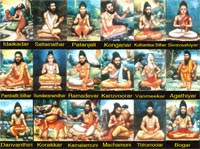We usually term the following five elements viz., earth, air, fire, water and sky as pancha bootham. Both earth and all the beings (living and non-living) enclosed in earth are composition of the above said five basic elements. However, the proportion of these 5 elements varies from one being to another and is unique. That is why Siththars says “andaththil ullathae pindam, pindaththil ullathae andam” which literally means “whatever is in universe lies in beings and vice versa”.
The changes, i.e. alteration in equilibrium or deficiency of one or more element, in composition of these 5 elements in humans induces aging, disease etc,. Siththar’s medicine basicly focuses on handling these 5 elements to keep it in equilibrium.
As Siththars are highly aware of elements composition in all beings and hence not only capable of altering those proportions in humans but also they are capable of changing any thing on their need and will. What we call in nowadays science as atomic and molecular studies! It is none other than the basis of our Siththar’s medical practice and alchemy.
Agathiyar in his book “Agathiyar paripooranam” listed out the principal compound of five basic elements viz., earth, air, fire, water and sky as follows in his poem:
ஆடவே அட்டசித்துந் தானேயாட
aadavae attasithththun thaanaeyaada
அடங்கிநின்ற பூதவகைச் சரக்குக்கேளு
adangininra poothvakaich sarakkukaelae
போடவே காரவகை பதிமூன்றுந்தான்
poadavae kaaravakai pathimoonrunthaan
பாங்கான பிருதிவியென றறிந்துகொள்ளு
paangkaana piruthiviyena rarinthukollu
கூடவே சாரவகை பன்னிரெண்டுந்தான்
koodavae saaravakai pannirendunthaan
குறியாக அப்புவெனக் கூர்ந்துபாரு
kuriyaaka appuvenak koornthupaaru
வாடவே வைப்புவகை முப்பத்திரெண்டு
vaadavae vaippuvakai muppaththirendu
வரிசையுடன் தேயுவென மகிழ்ந்துகாணே
varisaiyudan thaeyuvena makizhnthukaanae.
காணவே விளைவுவகை முப்பத்திரெண்டுங்
kaanavae vilaivuvakai muppaththirendung
கருவான வாயுவெனக் கனிந்துபாரு
karuvaana vaayuvenak kaninthupaaru
பூணவே உபரசம்நூத் திரண்டுபத்தும்
poonavae uparasamnooth thirandupaththum
புத்தியுட னாகாச மென்றுபாரு
puththiyuda naakaasa menrupaaru
தோணவே வகையறிந்து பஞ்சபூதம்
thonavae vakaiyarinthu panchapootham
சுத்தமுள்ள சரக்குவகை யறிந்துகொண்டு
suththamulla sarakkuvakai yarinthukondu
பேணவே சத்துருமித் துருவைக்கண்டு
paenavae saththurumith thuruvaikkandu
பிரியமுடன் சரக்குகளைக் கட்டிப்பாரே
piriyamudan sarakkukalaik kattippaarae.
There are 13 types of compounds (kaara vakai) which principally focuses soil/earth elements.
There are about 12 compounds (saara vakai) principally focusing water elements.
There are 32 compounds (vaippu vakai) principally focusing fire elements.
Air element has its principal dominance on 32 compounds (vilaivu vakai).
And finally, space element has its dominance over 100 compounds (uparasa vakai).
These are the basic composition of panchabootham and one should be well versed in all the above before starting their practice in field of medicine and alchemy. Then, next step is learning or knowing the combination of one or more of the above said elemental compounds and its effects.
What are those effects?
We shall see the continuation in upcoming post.
Original - www.siththarkal.com
Translated by Lalithambika Rajasekaran

